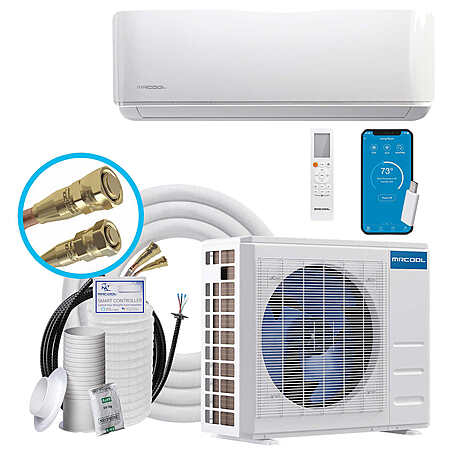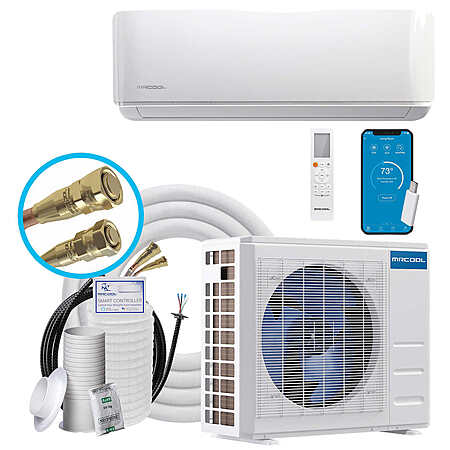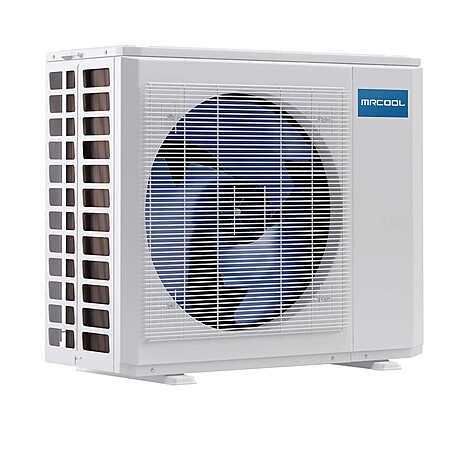expiredpanini posted Apr 01, 2024 06:58 PM
Item 1 of 3
Item 1 of 3
expiredpanini posted Apr 01, 2024 06:58 PM
Costco Members: MrCool E Star DIY 12K BTU Ductless Mini-Split Heat Pump System
& More + Free S/H$1,250
$1,400
10% offCostco Wholesale
Visit RetailerGood Deal
Bad Deal
Save
Share






Leave a Comment
Top Comments
I nearly bought the DIY unit so I wouldn't have to mess with a vacuum, but now I'm glad I went that route to save money and learn along the way. You got this!
The install for this can be very involved but it will really depend on your situation layout and skill level. If you get a 120v/15' hose unit that you can plug in to a standard recepticle, mount the head on the wall, drill a hole and shove the lines outside, then mount the unit on the siding or a concrete pad outside the wall, this install will likely be pretty easy.
It also be a pain as well though once you get into the 240v units if you aren't set up for it. I'm an electrician by trade and it took me 50 hours to install mine. That involved quite a few steps:
-Coring a 3" hole through brick, running lines up and through my garage and out the side wall.
-Setting up a chain-fall to hoist the condenser into the air, plus buying wall brackets and placing backing board in the walls with lag bolts to make damn sure it was solid.
-I bought the line gutter kit to give it a really clean install, highly recommend it.
-Run 1/2" conduit from my panel to a junction box outside the house, through the garage, to a disconnect under the unit.
-Installed 30 amp breaker and pulled 2 circuits a neutral and a ground, 10awg. The condenser doesn't need the neutral but you need a service gfci recepticle within a reasonable distance of the condenser unit. Plus it's been great having a plug out there now.
Sorry for the long ass post but take a few minutes with a pen and paper and a measuring tape before starting a project like this. What length of lines are you getting, how are you going to hide them? (coiling them up neatly behind the condenser is fine) What kind of walls are you drilling through, where is the condenser mounting, what voltage system will you need?
A 3" masonry core bit, wall brackets, gutters, EMT conduit, disconnect, hose and conduit supports, wire, chainfall; that's all things I hadn't anticipated but were made possible by my sponsors Amazon next day shipping and repeated trips to Home Depot heh.
Wish I knew how to host pics because it turned out great though. Good luck and safe installs everyone 👍
119 Comments
Sign up for a Slickdeals account to remove this ad.
4 years old now.
crazy it is more expensive now than what I paid , $1300 for the 18k DIY at home Depot
paid $125 for install.
$500 for 220v line outside
Our community has rated this post as helpful. If you agree, why not thank desantma
I never had a single issue in the 7 years I operated the unit, and it ran for all intents and purposes full time. The key is getting the drain hose correct so it doesn't back up. The only issue I had was self caused, it wasn't major I just should have angled it down an additional 2 degrees and everything would have been perfect.
If I were to need one of these again I would without hesitation buy one again.
Our community has rated this post as helpful. If you agree, why not thank pezjono
I nearly bought the DIY unit so I wouldn't have to mess with a vacuum, but now I'm glad I went that route to save money and learn along the way. You got this!
Our community has rated this post as helpful. If you agree, why not thank pezjono
Sign up for a Slickdeals account to remove this ad.
Our community has rated this post as helpful. If you agree, why not thank Sinjin28
The install for this can be very involved but it will really depend on your situation layout and skill level. If you get a 120v/15' hose unit that you can plug in to a standard recepticle, mount the head on the wall, drill a hole and shove the lines outside, then mount the unit on the siding or a concrete pad outside the wall, this install will likely be pretty easy.
It also be a pain as well though once you get into the 240v units if you aren't set up for it. I'm an electrician by trade and it took me 50 hours to install mine. That involved quite a few steps:
-Coring a 3" hole through brick, running lines up and through my garage and out the side wall.
-Setting up a chain-fall to hoist the condenser into the air, plus buying wall brackets and placing backing board in the walls with lag bolts to make damn sure it was solid.
-I bought the line gutter kit to give it a really clean install, highly recommend it.
-Run 1/2" conduit from my panel to a junction box outside the house, through the garage, to a disconnect under the unit.
-Installed 30 amp breaker and pulled 2 circuits a neutral and a ground, 10awg. The condenser doesn't need the neutral but you need a service gfci recepticle within a reasonable distance of the condenser unit. Plus it's been great having a plug out there now.
Sorry for the long ass post but take a few minutes with a pen and paper and a measuring tape before starting a project like this. What length of lines are you getting, how are you going to hide them? (coiling them up neatly behind the condenser is fine) What kind of walls are you drilling through, where is the condenser mounting, what voltage system will you need?
A 3" masonry core bit, wall brackets, gutters, EMT conduit, disconnect, hose and conduit supports, wire, chainfall; that's all things I hadn't anticipated but were made possible by my sponsors Amazon next day shipping and repeated trips to Home Depot heh.
Wish I knew how to host pics because it turned out great though. Good luck and safe installs everyone 👍
For me that would be the COP, or basically what multiple of kw gets you a net kw out in terms of heat. That makes it rather easy to compare heating types, or more concisely, which heating type to use based on the season. I have a few heating types - primary NG/boiler/baseboard, pellet stove, several heat pumps, and propane and NG fireplaces depending on the room. All of these things cost differently depending on how they are priced, but what I wanted to know is, when does operating the heat pump become more expensive than gas? Unfortunately finding the COP for any given unit, much less how that varies with outdoor temperature, is difficult if not impossible.
The install for this can be very involved but it will really depend on your situation layout and skill level. If you get a 120v/15' hose unit that you can plug in to a standard recepticle, mount the head on the wall, drill a hole and shove the lines outside, then mount the unit on the siding or a concrete pad outside the wall, this install will likely be pretty easy.
It also be a pain as well though once you get into the 240v units if you aren't set up for it. I'm an electrician by trade and it took me 50 hours to install mine. That involved quite a few steps:
-Coring a 3" hole through brick, running lines up and through my garage and out the side wall.
-Setting up a chain-fall to hoist the condenser into the air, plus buying wall brackets and placing backing board in the walls with lag bolts to make damn sure it was solid.
-I bought the line gutter kit to give it a really clean install, highly recommend it.
-Run 1/2" conduit from my panel to a junction box outside the house, through the garage, to a disconnect under the unit.
-Installed 30 amp breaker and pulled 2 circuits a neutral and a ground, 10awg. The condenser doesn't need the neutral but you need a service gfci recepticle within a reasonable distance of the condenser unit. Plus it's been great having a plug out there now.
Sorry for the long ass post but take a few minutes with a pen and paper and a measuring tape before starting a project like this. What length of lines are you getting, how are you going to hide them? (coiling them up neatly behind the condenser is fine) What kind of walls are you drilling through, where is the condenser mounting, what voltage system will you need?
A 3" masonry core bit, wall brackets, gutters, EMT conduit, disconnect, hose and conduit supports, wire, chainfall; that's all things I hadn't anticipated but were made possible by my sponsors Amazon next day shipping and repeated trips to Home Depot heh.
Wish I knew how to host pics because it turned out great though. Good luck and safe installs everyone 👍
Sign up for a Slickdeals account to remove this ad.
Leave a Comment